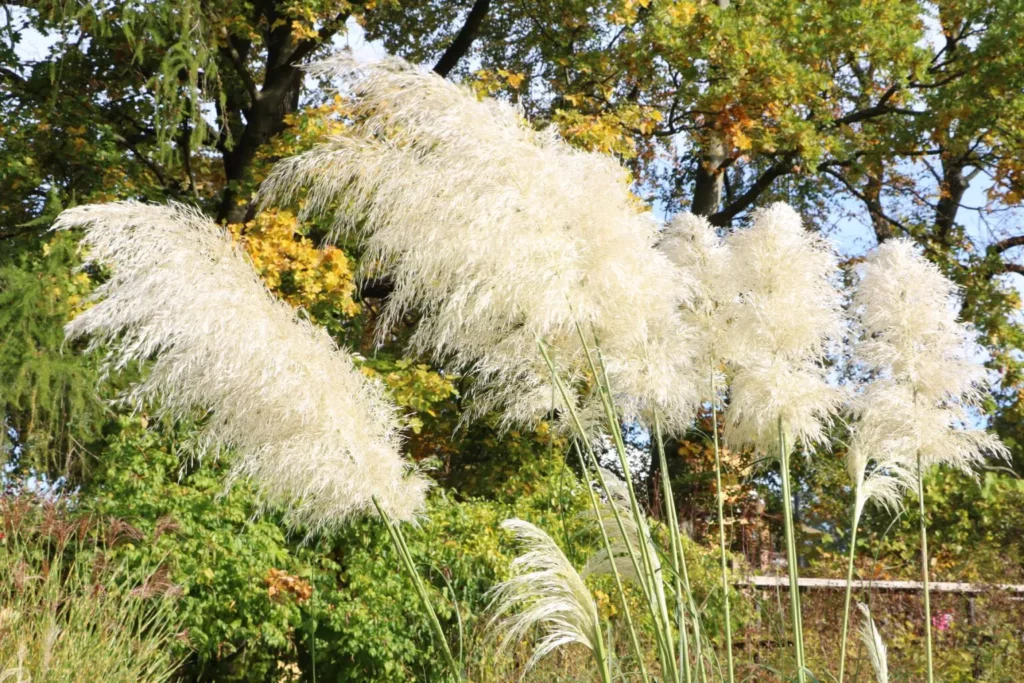Pampas grass is a low-maintenance ornamental grass that occasionally gives gardeners a scare when it looks withered in the fall. Usually it’s just a natural process and it sprouts again.
Contents
Winter preparation
Like many plants, pampas grass (Cortaderia selloana) also prepares for the cold season in the fall. For this purpose, in the first step, the dyes are broken down and then the culms are no longer supplied. Over the course of several weeks, the blades then dry out. The plant shifts all its supply to the root area, where it also forms new beginnings for shoots.
This process is not a cause for concern, but the ornamental grass needs some help to get through the winter well. It is important to protect the rootstock and not cut the grass.
Winter preparation:
- Do not cut
- Tie stalks together in a bundle over the top of the aerie
- Support bundle if necessary
Choose the right location
Although ornamental grass is hardy, the wrong location can harm the plants. Shade is especially problematic. Even partial shade can cause the blades to look limp and the pampas grass to eventually dry up. In this case, the ornamental grass is easy to save, it just needs to be transplanted to a suitable location.
Requirements for the location:
- full sun
- protected from the wind
- nutrient-rich soil
- well-drained and humus-rich soil
Water properly
The pampas grass is originally from South America and tolerates longer periods of drought very well. However, it should not dry out completely. Check the top layer of soil around the aerie; if it is still dry at a depth of five to ten centimeters, you should water thoroughly once.
Watering tips:
- Do not water into the eyrie
- Water the area around the eyrie
- water several times with 20 minutes interval
- Always allow enough time for the water to percolate in between. As soon as a puddle forms, stop watering and wait until the water has completely seeped away.

Avoid waterlogging
The ornamental grass copes well with dryness, in contrast to moisture. Therefore, when watering, always make sure to water thoroughly, but avoid waterlogging. The root system reacts very sensitively to this and it can even lead to the death of the roots.
If root rot is already threatening, you do not have much time to save the plants. Proceed as follows:
- Dig up pampas grass
- shake off the soil and wash off the rest
- cut off broken roots
- divide horst in case of severely damaged plants
- replant healthy parts
- Prevent nutrient deficiency
A nutrient deficiency is occasionally accompanied by a prolonged drought. Without water, the plant can also no longer absorb sufficient dissolved nutrients. Get first aid to the plants by watering thoroughly. If the culms still appear limp, you should increase fertilization.
Tips for fertilizing:
- Basic fertilization in spring
- combine organic and mineral fertilizers
- Use fertilizer with moderate nitrogen content such as compost
- fertilize repeatedly if the soil is permeable
Regular pruning
An important maintenance measure for pampas grass is regular pruning. If the grass is not cared for, it can happen that the clumps in the middle begin to die. New shoots often struggle to grow through the dense canopy, but then quickly appear limp because the culms in the middle can no longer be adequately supplied.
Pruning should be done in the spring before sprouting. It is important not to cut the grass too early so that the canopy is not damaged by frost. Everything that has dried up above ground on the pampas grass, cut off at a height of about ten centimeters.
Due to pruning the tender shoots have enough light. In addition, the eyrie is warmed by the spring sun, which also promotes the formation of young shoots.
Frequently asked questions
Can pampas grass in a pot die back in the fall?
Pot culture is a little more complex. In the fall, the grass also moves in when grown in pots. For pampas grass in a pot, there is a higher risk of it drying out or the roots being damaged by frost. In winter, the grass should be watered on frost-free days. In addition, the root ball should be wrapped thickly with a jute bag and placed on a wooden board.
How can I prevent waterlogging?
Before planting the pampas grass, fill in a drainage of lava granules in the planting pit. On top of it put some substrate and then the ornamental grass. As the size of the clumps increases, you should also increase the drainage.
Is it normal that the leaves dry up after transplanting?
Yes, it can happen that the ornamental grass looks limp after transplanting and shoots even wilt. This is normal because transplanting usually damages the roots, which prevents the plant from adequately feeding the culms. The plants usually recover when new roots have formed.


